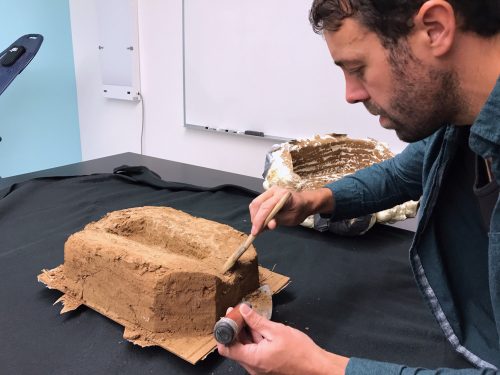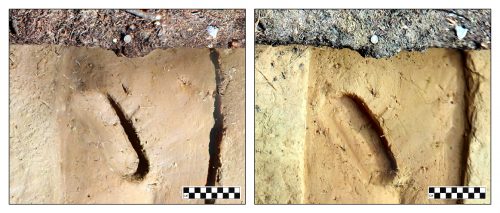UAF-led team discovers ancient human footprint
May 23, 2019
Jeff Richardson
907-474-6284

The discovery of a prehistoric footprint at an Interior Alaska archaeological site is helping researchers create a more detailed picture of ancient Athabascan family life.
Researchers discovered the footprint, which likely belonged to a pre-teen child, in 2017 near a dwelling unearthed at the Swan Point archaeological site, located in the Shaw Creek Flats near Big Delta. Made more than 1,800 years ago, it’s the oldest known human footprint ever found in the North American sub-Arctic.
The print is among a range of intriguing finds at the site, which archaeologists have explored since archaeologist Charles Holmes discovered the site in 1991. Those include the remnants of dwellings, cache pits and a variety of stone artifacts.
Discovering a footprint at the site still provided a unique thrill, said Gerad Smith, a UAF doctoral candidate.
“As an archaeologist you’re always finding neat things, but when I tell people about this footprint it seems to strike a different emotional nerve,” said Smith, who wrote about the discovery in the March issue of the Journal of Archaeological Science: Reports.
Although it represents just a single footprint, the discovery also may help reveal some details about the lives of area inhabitants nearly two millennia ago. Steve Schoenhair, a University of Alaska Anchorage student, found the footprint while excavating a layer that served as the “living floor” of the site, just outside an oval-shaped house pit.
Someone wearing a soft-soled shoe like a moccasin made the print, which is equivalent to a modern shoe size 5 ½. Carbon dating of the surrounding area determined it was formed between 1,800 and 1,900 years ago.

Smith said researchers were initially skeptical that they could determine if it was an actual footprint, but its identity became clearer after they scanned a plaster mold of the print at UAA. A heel, arch and balls of the foot emerged in the digital image, forming the familiar outline of a human foot.
The depth of those features allowed researchers to estimate the weight of the person who made the footprint. That weight, along with the size of the print, indicated that an 8- to 11-year-old child with healthy body mass likely created the footprint.
The presence of an apparently healthy child at the site, along with the construction of the nearby dwelling, allows researchers to make some broad conclusions, Smith said. The excavated sod house was similar to the 19th century type that would belong to a “big man” in the village. The presence of a child at the site suggests the presence of a family that was relatively well-off while they lived there, according to the paper.
“When I see something like this, I see this probably belonged to someone from an important family,” Smith said.
Researchers recovered and preserved the footprint, and both it and a cast will eventually become part of the collection at the University of Alaska Museum of the North. Work at the Swan Point site continues this summer, with efforts focusing on another house pit excavation about 5 miles away in the same valley.
Other contributors to the study include University of Alaska Anchorage graduate student Ted Parsons, UAA anthropology associate professor Ryan Harrod, Holmes, UAF associate professor of anthropology Joshua Reuther, and UAF anthropology professor Ben Potter.


